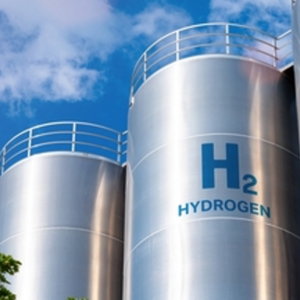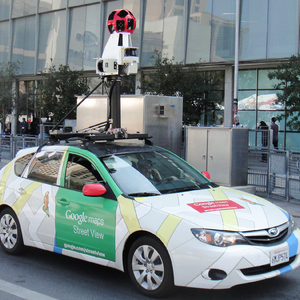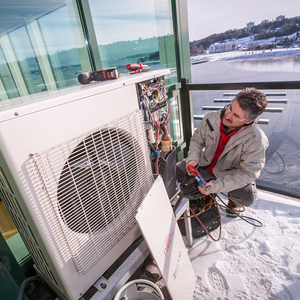
This post was originally published at Yale Environment 360.
In 1836, Philadelphians mostly used whale oil and candles to light their homes and businesses. That year, the newly formed Philadelphia Gas Works caused a stir when it lit 46 downtown street lamps with gas made from coal in its plant on the Schuylkill River. By the end of the Civil War, public thoroughfares and private dwellings in the core of most large Eastern cities were illuminated by gas, supplied through cast iron pipes buried beneath the busy streets—and the whale oil lighting industry was nearly dead.
Philadelphia’s own pipe network has expanded over the past 185 years to encompass 6,000 miles of gas mains and service lines. But today, Philadelphia Gas Works (PGW)—the largest municipal gas utility in the country—is the incumbent business staring down existential threats, facing challenges from new technologies, upstart rivals, and a quickening 21st-century energy transition that aims to convert many buildings from gas to electricity.
In recognition of these forces and the city’s own climate action plan, Philadelphia has commissioned a “diversification study” to find a new low-carbon business model for the nation’s oldest gas utility, which delivers natural gas to 510,000 customers.
Earlier this year, Philadelphia announced a target of achieving net-zero greenhouse gas emissions by 2050. “There’s just no way that can happen without PGW changing,” said Tom Shuster, clean energy program director of the Sierra Club’s Pennsylvania chapter, which advocates for wider building electrification. Gas sold by the utility is the single biggest source of the city’s climate-warming pollution, accounting for 22% of its greenhouse gas emissions.
Charting a path forward that ensures both PGW’s survival and the city’s carbon neutrality will be a heavy lift, many advocates acknowledge. The task is even more daunting when considered on a national scale. While many cities are adopting or considering rules that require new construction to be all-electric, the much thornier problem is how to get fossil fuels out of existing buildings, which account for about 30% of U.S. greenhouse gas emissions.
Of the country’s 120 million households, about 58% are heated primarily with natural gas. To zero out carbon emissions from those homes, all of their furnaces, water heaters, and other appliances will have to be fueled with “green molecules” (such as biogas, hydrogen, and synthetic gases) instead of fossil gas, or swapped out for heat pumps and other devices powered by renewable electricity.
Planning a long-term getaway from gas
Several states have already begun formally planning their long-term transition away from natural gas. Last June, the attorney general of Massachusetts petitioned the state’s utility regulators to investigate how to transition away from natural gas. Spurred by their own climate action goals, California and New York have launched similar efforts. New Jersey’s Energy Master Plan has set a goal of electrifying 90 percent of buildings’ heating and cooling demand by 2050.
The menu for building decarbonization includes heat pumps powered with renewable electricity, geothermal systems, hydrogen fuels, and biogas generated from organic waste. Some of these solutions are in the early stages of development and deployment. Air-source heat pumps are the most mature technology, with decades of use in parts of Europe and Japan, and in the U.S. South, where heat pumps make up more than 20% of building heating systems.
A few gas utilities are experimenting with blending hydrogen into their gas mix and testing how appliances handle it, in the hopes that “green hydrogen,” created with renewable electricity, will help them wring the carbon out of their operations. And Eversource, New England’s largest energy utility, is partnering with Home Energy Efficiency Team (HEET), a Massachusetts-based nonprofit focused on cutting emissions from the building sector, to build an innovative pilot geothermal district heating and cooling system in the Boston area this summer.
In any scenario, a massive transformation of the way we use energy in buildings will be required to meet ambitious city, state, and federal emissions targets. Perhaps nowhere are these challenges as stark as in older cities in the Northeast, which remain heavily reliant on natural gas for heating and have some of the oldest, least energy-efficient housing stock.
In Philadelphia, overhauling PGW entails navigating a thicket of competing imperatives beyond cutting greenhouse gas emissions: plugging dangerous methane leaks, retaining or retraining the utility’s 1,600-strong workforce, and ensuring that the most vulnerable Philadelphians aren’t left carrying the burden of propping up an increasingly expensive gas grid.
Income disparities add a twist to the problem
Even before the pandemic led to a recent spike in unpaid bills, many Philadelphians faced an energy affordability crisis. Philadelphia has the highest poverty rate of any major U.S. city; roughly one third of PGW’s customers are low-income. To be equitable, any transition for the utility must “make sure every last person reliant on natural gas has a way to keep warm in winter, cook their food, and heat their water,” said Elizabeth Marx, executive director of the Pennsylvania Utility Law Project, which represents the interests of low-income utility customers. “If you’re talking about shifting away from a system that’s been built out with ratepayers for decades, you can’t shift away easily without leaving people behind.”
As more affluent customers abandon gas to install heat pumps and other clean-energy upgrades with higher upfront costs, many advocates for a “just transition” worry that lower-income ratepayers will be left to foot the bill for maintaining PGW’s aging gas infrastructure.
“What you want to avoid is the situation where you have to maintain and spend money on the whole system, even while you sell less gas,” said Mike Henchen, who leads the building decarbonization program at the energy think tank RMI.
Meanwhile, some of that maintenance can’t wait, for safety and environmental reasons. In December 2019, a leak from a 92-year-old gas main caused an explosion that killed two people and leveled five rowhouses in South Philadelphia. The methane in those leaks is also a potent climate-warming agent; a 2019 study that sampled air over Philadelphia and five other East Coast cities found methane levels 2.5 times higher than suggested by emissions inventories from the Environmental Protection Agency.
Keeping an older system running
“Gas utilities are in a difficult bind,” said Audrey Schulman, the founder and co-executive director of HEET, the nonprofit that initiated the Massachusetts geothermal project. “At the same time that they have to decarbonize, they have to replace these aging gas pipes.”
The larger dilemma for Philadelphia’s officials—and for other municipal leaders around the country—is how long, and how much, to keep spending on gas infrastructure before “leapfrogging” to wider building electrification.
When Philadelphia Gas Works applied for an increase in its base rate to the state’s Public Utility Commission last year, the Sierra Club intervened, claiming that spending on pipe maintenance beyond what’s required by immediate safety concerns is unwise. “You’re asking for money to replace this entire system,” said the Sierra Club’s Shuster, “but in doing so you are likely putting in infrastructure that will not see the end of its useful life before it’s taken offline.”
The city commissioned the diversification study to address those kinds of tough tradeoffs. “There’s no clean silver bullet,” said Christine Knapp, director of Philadelphia’s Office of Sustainability. “It will probably wind up being a piecemeal strategy that gets us to our goals—a certain amount of renewable natural gas, geothermal, electrification, and weatherization, for example, that add up to having a bigger impact.”
Philadelphia Gas Works did not respond to requests for comment. But in testimony at a 2019 City Council hearing about the proposed diversification study, a PGW official emphasized regulatory and legal limits on the utility’s ability to evolve beyond its narrow mission of delivering natural gas. Through its own direct advocacy and its membership in the American Gas Association, an industry trade group, the utility has opposed the updating of building codes that would have encouraged state and city governments to require more efficient appliances and electrification-ready wiring.
In one of the paths being studied, PGW would keep its pipe-based system and simply add more low-carbon gas molecules to its fuel mix. For instance, SoCalGas, the nation’s largest gas utility, has heavily pushed the promise of wider use of biogas (also known as “renewable natural gas”) made from organic waste as a rationale for preserving and expanding gas infrastructure, and for resisting calls to ban the use of gas in new construction. Many other gas utilities have been promoting their nascent efforts to decarbonize by blending biogas and hydrogen into their natural gas supply.
But that path would still mean pumping molecules of climate-warming methane through leak-prone pipes. And there are physical and financial limits on how much hydrogen and biogas could substitute for fossil gas. Various estimates peg the total potential supply of renewable natural gas at anywhere from 2% to 12% of total natural gas demand. Renewable natural gas and hydrogen are also still expensive fuels to manufacture.
Fully electric is a cheaper path
Several recent studies have found that fully electrifying buildings is a lower-cost way to decarbonize than going the “green molecules” route. In one, researchers estimated that the monthly cost of running a heat pump would range from $34 to $53, whereas running a gas furnace on renewable natural gas would cost $160 to $263. Heat pumps’ appeal to both homeowners and policymakers is on the rise even in the cold Northeast: Maine, for example, has a mandate to install 100,000 heat pumps in homes and businesses by 2025.
But even if operating a heat pump is likely cheaper over the long run than firing a furnace with biogas, the upfront cost of buying and installing one—including upgrading wiring and circuit breakers to handle heavier loads—remains high relative to a conventional gas heater. Those costs are still well beyond what many Philadelphians can afford.
One company is advancing a new way to overcome that hurdle. BlocPower is a Brooklyn-based startup that specializes in energy retrofits of large urban buildings, with a focus on converting affordable housing and multi-family buildings from fossil fuel heating to renewably powered heat pumps. With over 1,000 building retrofits in New York under its belt, BlocPower is expanding to cities across the country, including Los Angeles and Chicago. The company sees Philadelphia as fertile terrain.
“Philadelphia has many pre-war-era walkups and multifamily buildings in dense areas that we deem to be very similar and applicable to the work we’ve been doing to date,” said Ian Harris, BlocPower’s business manager.
BlocPower began working with Philadelphia in 2014, participating in a multi-family housing pilot project led by the Philadelphia Energy Authority. This month it plans to launch BlocMaps Philly, a software tool that helps city planners and individual building owners model the potential for reducing both emissions and energy bills by installing air-source heat pumps and other systems, such as batteries and solar microgrids. Within the next 12 months, the company aims to complete 500 projects in Philadelphia.
BlocPower manages every stage of the project, from design to installation, and offers building owners the option to lease the system. BlocPower’s model seeks to remove the traditional barriers to greening low-income urban housing, including the challenge of securing loans. The company uses algorithms to estimate a building’s potential energy savings, and then uses those projected savings to secure financing from institutions like the New York Green Bank and Goldman Sachs. It aims to demonstrate that investors can earn stable, long-term returns on investments in urban heat pumps, not unlike what they would expect from municipal infrastructure bonds.
“We see a great opportunity to transition as many as people as possible off fossil fuels in Philadelphia,” said Harris.
Same old pipes, but a new use
Others still see a role for pipes in the city’s energy future. This summer, Eversource Gas, the investor-owned private utility in the Boston area, will break ground on the first demonstration of HEET’s innovation. The nonprofit has developed a concept called the GeoMicroDistrict, which would link buildings on a given street or block into a networked geothermal energy system.
The system is powered by ground-source heat pumps, extremely energy-efficient devices that use water as a medium for sharing thermal energy between buildings, sending heat where it’s needed and away from where it isn’t. The geothermal districts tap the constant temperature of the ground, and can themselves be further linked together into larger networks.
The biggest upfront costs are associated with installing the system, including the drilling of shallow, six-inch-wide boreholes; after that, operating costs are low. Utilities like PGW could absorb those steep capital costs and spread them out over time and over their wide user base, taking advantage of economies of scale, said Zeyneb Magavi, the co-executive director of HEET. The geothermal pipes could be laid in the same rights-of-way already used for gas pipes. Geothermal systems could also preserve more jobs, she added, leveraging the expertise of utility workers, many of whom are trained to install the same kind of plastic pipes.
“We have to work with the pieces we have,” said Magavi. “The fastest way forward is to flip utilities’ financing mechanisms and customer networks, all these pieces that we can redirect toward building a better energy system.”
Whatever decarbonization path Philadelphia chooses, as a first step Mike Henchen of RMI would like to see PGW identify one segment of the city’s gas network—a neighborhood, a street, a discrete block of buildings—to shut off. “They can work to support every building served by that portion to convert to a carbon-free alternative to gas, and then decommission an actual pipe in the ground,” Henchen said. “Close the valve.”
This kind of strategic abandonment, he argues, would be the most transformative step that PGW could take—one that would acknowledge that a smaller gas delivery system is needed in any likely scenario, and that would signal to city, state, and utility leaders around the country where the future is heading for the entire gas distribution industry. “If they could do that,” said Henchen, “that would really be ground-breaking.”
Jonathan Mingle is a freelance journalist and the author of Fire and Ice: Soot, Solidarity, and Survival on the Roof of the World.
Weekly Newsletter
Get building science and energy efficiency advice, plus special offers, in your inbox.















12 Comments
Not even a token mention of a Pigouvian pollution tax and letting market forces work?
Remember that in the end it is customers who carry the burden of paying taxes.
Whatever happens will be interesting because ultimately pensions are at stake and pensioners vote early and often. I suspect the financial burden of sunsetting the gas utilities will fall on all residents of PA.
"researchers estimated that the monthly cost of running a heat pump would range from $34 to $53, whereas running a gas furnace on renewable natural gas would cost $160 to $263."
Show us the numbers.
Sounds about right.
Okay, I get it now. Eliminate natural gas and look how much cheaper electricity is!
"The report cites an analysis by the American Gas Foundation (AGF), an independent research arm of a gas industry group, which found that some sources of RNG could cost between $7 and $20 per million British thermal units by 2040, but others could be as high as $45. Right now, the cost of natural gas is only $2 to $3 per million British thermal units, so a switch to RNG could mean steep rate hikes for customers."
Our local utility, Heritage Gas, charges a $21.87 monthly fee to access their network and, this winter, their residential rate (for the non-renewable variety) was set at $18.09 per GJ.
Our home's estimated space heating demand so far this winter is 13,881 kWh. Assuming an AFUE of 90 per cent, that translates to be something in the order of 55.5 GJ or $1,004.00 at current prices. Add in the account fee, and the final cost is $1,266.00.
Our two, mid-efficiency ductless heat pumps (9.3 HSPF) have consumed 3,803 kWh thus far this winter which, for us, typically spans 01 October through 31 May; at 16.088-cents per kWh, my operating cost is $612.00, or a little less than half that of natural gas.
Nova Scotia being at the tail end of a rather long pipe, natural gas is not your least cost option in these parts.
Thanks a lot for your local information. It was eye opening to me, and it truly points out the fact that regional differences need to be considered.
So let's look at Philadelphia, featured in the blog, and a city dear to my heart as I lived there for over 20 years. According to BLS stats,(https://www.bls.gov/regions/mid-atlantic/news-release/averageenergyprices_philadelphia.htm#:~:text=Philadelphia%2Darea%20households%20paid%20an,per%20therm%20a%20year%20earlier.), Philadelphians pay $10.95/MCF for natural gas and $0.152/kWh for electricity. In comparable terms, the cost of NG is $0.037/kWh. So one would require a COP of 4.1 to pay the same price for heating. Philadelphia gets its electricity from the RFC east subgrid. It uses 12% coal, 46% NG, 37% nuclear, and, wait for it....5% renewables...to generate this electricity.
Most people in Philadelphia are poor. Should we eliminate their natural gas? (I'm not asking you specifically, CollieGuy, just presenting the question for those who seem so certain that this is the right path.)
I live maybe 1.5 hours out of Philadelphia on the eastern edge of Lancaster Co. We just moved in to our double stud super-insulated airtight home. It's about 2100 sq ft and heated by minisplits. Our highest electric bill in the coldest part of winter was over $200 and now it's down to about $100. I'm guessing more than half that bill is the minisplits. So I'm not seeing this $34-53 price range unless you're talking about a much smaller home.
Fred, a 300% COP heat pump fed by 12% coal and 46% natural gas generation at the US average emissions levels produces 40% less emissions than a 99% efficient gas furnace. Emissions wise, it's no contest and will only improve as coal plants close. PGW already subsidizes low income customers with no drama, no reason why that would have to change if they used electricity instead.
Paul, thanks for pointing this out. IF by emissions you mean strictly CO2, then I agree with your calculation. However, let's agree that the reason for this is the reliance of the grid on nuclear energy. Are we supportive of nuclear energy? (I personally hope so). Furthermore, electricity generates twice the NOx as NG, 58 times more SO2, and 5 times more N2O. Finally, almost all particulate matter comes from coal burning so electricity produces essentially infinitely more particulate matter than NG. Not to mention arsenic, selenium, mercury,... Let's focus our efforts on eliminating coal from the fuel mix, not NG from the home.
There are 400,000 rowhouses in Philadelphia, almost all of which are vented for non-condensing furnaces that generate hot water/steam to supply cast iron radiators. I can't find specific numbers, but I remember reading somewhere that about 20% of these homes are still heated with fuel oil. These folks have a real financial incentive to switch fuels, but typically they go with natural gas as an upgrade. If we could focus on these houses, and incentivize the installation of heat pumps, we would see enormous returns per unit in terms of reduced, less toxic emissions. There are no air vent systems in these homes so initial installation costs would be quite high.
You make good points. You're exactly right - heating oil and coal have no place in our future should be removed as quickly as possible. If natural gas has a role, it's best suited for electricity generation for now - even a 100% natural gas grid powering a 300% COP heat pump has 32% lower emissions than a standard efficiency gas furnace, 20% lower than a 99% furnace.
I think the fuel mix to think about is renewables, storage, and natural gas, as the coal industry is in freefall and nuclear capacity can only be maintained, doubtful we'll see any nuclear plants start and finish construction within the decade.
I'm curious about where all the new electric generation is going to come from? My impression is that it takes many years to go through the environmental, safety and other hoops just to get the permit to build. Should I be investing in electric companies?
Log in or create an account to post a comment.
Sign up Log in